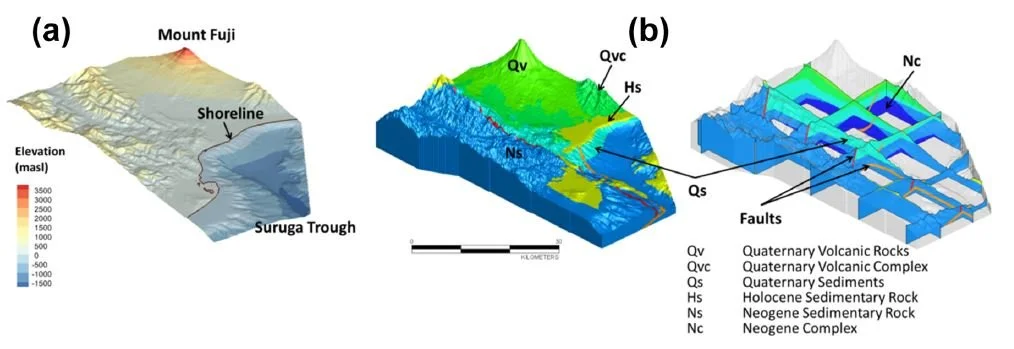Staff Research Highlight - Steady-state density-driven flow and transport: Pseudo-transient parameter continuation
Park, Y.-J., Hwang, H.-T., Hasegawa, T., Okamoto, S., Ozutsumi, T., Tanaka, T., Morita, Y., & Illman, W. A. (2023). Steady-state density-driven flow and transport: Pseudo-transient parameter continuation. In Advances in Water Resources (Vol. 173, p. 104380). Elsevier BV. https://doi.org/10.1016/j.advwatres.2023.104380
“Using HydroGeoSphere, we performed a proof-of-concept demonstration to show the computational efficiency of the suggested method and applied the PTPC method to a real-world problem, to evaluate the long-term safety design of a hypothetical radioactive waste repository located in a coastal area. ”
We’re pleased to highlight this publication, co-authored by Aquanty’s senior scientist, Hyoun-Tae Hwang, which presents a new numerical approach for efficiently solving steady-state density-driven flow and transport equations— an important challenge in groundwater modelling, particularly for coastal aquifers affected by saltwater intrusion. The research introduces a hybrid technique called pseudo-transient parameter continuation (PTPC), which combines the robustness of pseudo-transient continuation (PTC) methods with the computational efficiency of parameter continuation (PC) strategies.
Figure 11. (a) Groundwater discharge and (b) vertical profiles of salinity and groundwater velocity with depth.
The study emphasizes the importance of understanding interactions between freshwater and saline water in coastal aquifers, especially in light of increasing risks posed by climate change and excessive groundwater pumping. Traditional models often face convergence issues or excessive computational demands when simulating these interactions due to the nonlinear nature of the equations governing density-driven flow. The PTPC method proposed in this study overcomes these limitations by gradually adjusting fluid density within a transient simulation framework, improving convergence and reducing computational load.
The authors applied PTPC in both a proof-of-concept setting and a real-world case study in Suruga Bay, Japan (Figure 1) — a coastal region considered for radioactive waste storage. The results demonstrated that PTPC could achieve steady-state solutions with significantly fewer timesteps and iterations compared to traditional transient or parameter continuation simulations. In the Suruga Bay model, PTPC successfully captured freshwater-saltwater interactions while significantly cutting down computational time, making it a valuable method for long-term simulations of coastal aquifer systems.
“An integrated surface-subsurface HydroGeoSphere model solves the coupled linear equations using the Picard linearization method, which has been widely applied for density-driven flow and transport problems. Although the Picard method has been successfully applied to nonlinear problems, issues related to its convergence can arise for problems with high density ratios and large and highly nonlinear systems.”
HydroGeoSphere (HGS) played a central role in this study as the modelling platform used to implement and test the PTPC methodology. HydroGeoSphere’s ability to simulate coupled surface-subsurface hydrologic processes and handle density-dependent flow and transport was critical in accurately modelling the interactions between freshwater and seawater in the complex geological setting of the Suruga Bay region. HydroGeoSphere’s flexibility and numerical strength made it ideal for implementing the novel PTPC approach and conducting high-resolution simulations over geologic timescales.
By advancing the numerical tools available for density-driven groundwater modelling, this research provides a pathway for more reliable and efficient analysis of coastal aquifer behaviour, particularly under long-term climate and land use changes. It also offers valuable insights for repository safety assessments, coastal water management, and broader hydrogeological applications involving saline intrusion.
Abstract:
Density-driven flow and transport is one of the dominant physical processes in coastal aquifer systems. To better manage water resources in coastal areas, the interactions need to be understood between freshwater and denser seawater. Numerical models often suffer from excessive computational cost to simulate the equilibrium steady state due to the nonlinear nature of the governing equations to describe density-driven flow. This study suggests a pseudo-transient parameter continuation (PTPC) approach which combines two general solution strategies for nonlinear steady-state equations: the pseudo-transient continuation (PTC) and parameter continuation (PC) methods. The new method gradually adjusts the maximum density (or parameter continuation) in the transient simulation framework (or pseudo-transient). The PTPC method is generally supposed to converge as in PTC and as efficiently as PC when the scheduling for parameter adjustment is set to be optimal. Through a proof-of-concept example, it is illustrated that the solution path to the steady state in PTPC is in between the paths from the PTC and PC approaches, depending on the level of aggressiveness of the parameter adjustment scheduling. As yet being empirical, the PTPC approach is promising and can be applicable to efficiently solve other steady-state nonlinear equations. The method was successfully applied to characterize and better understand the groundwater flow system in the Suruga Bay area, Japan.


